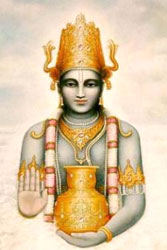
The origins of Ayurveda are unknown but it is thought that the principles on which our life is based and how we – at that time like today – are able to maintain our health, were passed on from family to family even more than 2500 years ago.
3000 BC. there was one of the largest cities in the world in the Indus Valley (now Pakistan) – probably the birthplace of Ayurveda. “Rig Veda”, the first of four Hindu scripts and one of the oldest written documents in the world, includes descriptions of operations, prostheses and the use of 67 herbs. Until 1200 BC. 100 diseases and eight medical special subjects were listed. The Vedic literature evolved in many different knowledge categories: Ayurveda, Vedic art of healing, as we know it today, has been formulated according to historians around 500 BC.
In the 3rd century BC. Buddhist King Ashoka ruled the majority of India. Under his patronage, gardens full of medical herbs arose and Ayurvedic hospitals administered free medicine. Ashoka supported the spread of Ayurveda to East Asia and thus the development of Chinese medicine. At the same time, the Greek physician Hippocrates developed similar ideas. Translations of Ayurvedic texts stimulated the development of Arabic medicine and thus influenced the medicine in Europe. The teaching and practice of Ayurveda have been suppressed from the 12th century in India firstly by Muslim then British rule during the colonial era. Around 1900 Ayurveda was applied again. Today there are over 300,000 Ayurvedic physicians or Vaidyas in India treating 60% of all Indians. The Indian government began to promote this medicine seriously, which is partly due to the growing international interest. In the West and in Japan Ayurvedic courses and medical associations spring up like mushrooms, proving the new and important status of this ancient doctrine.









